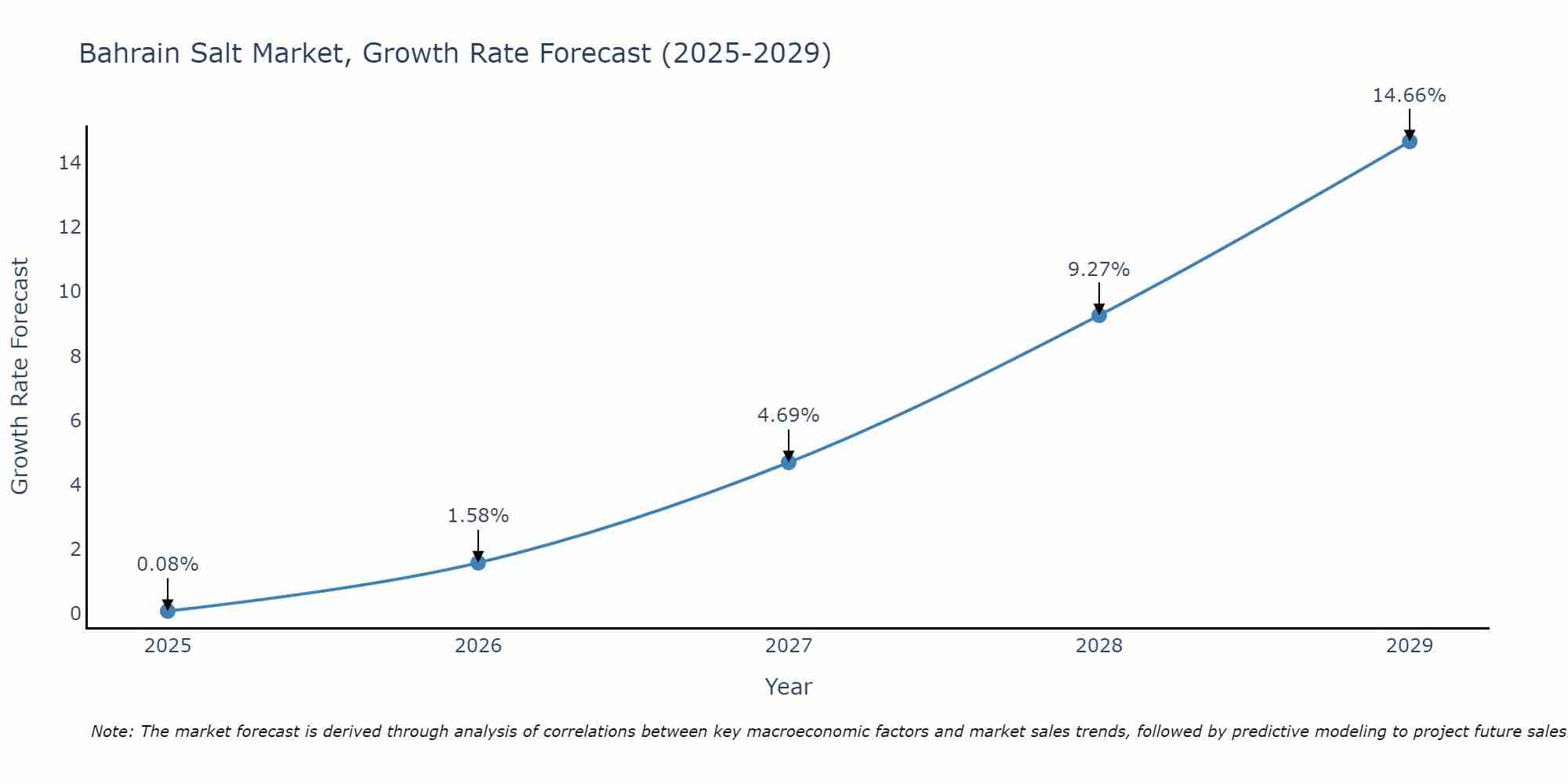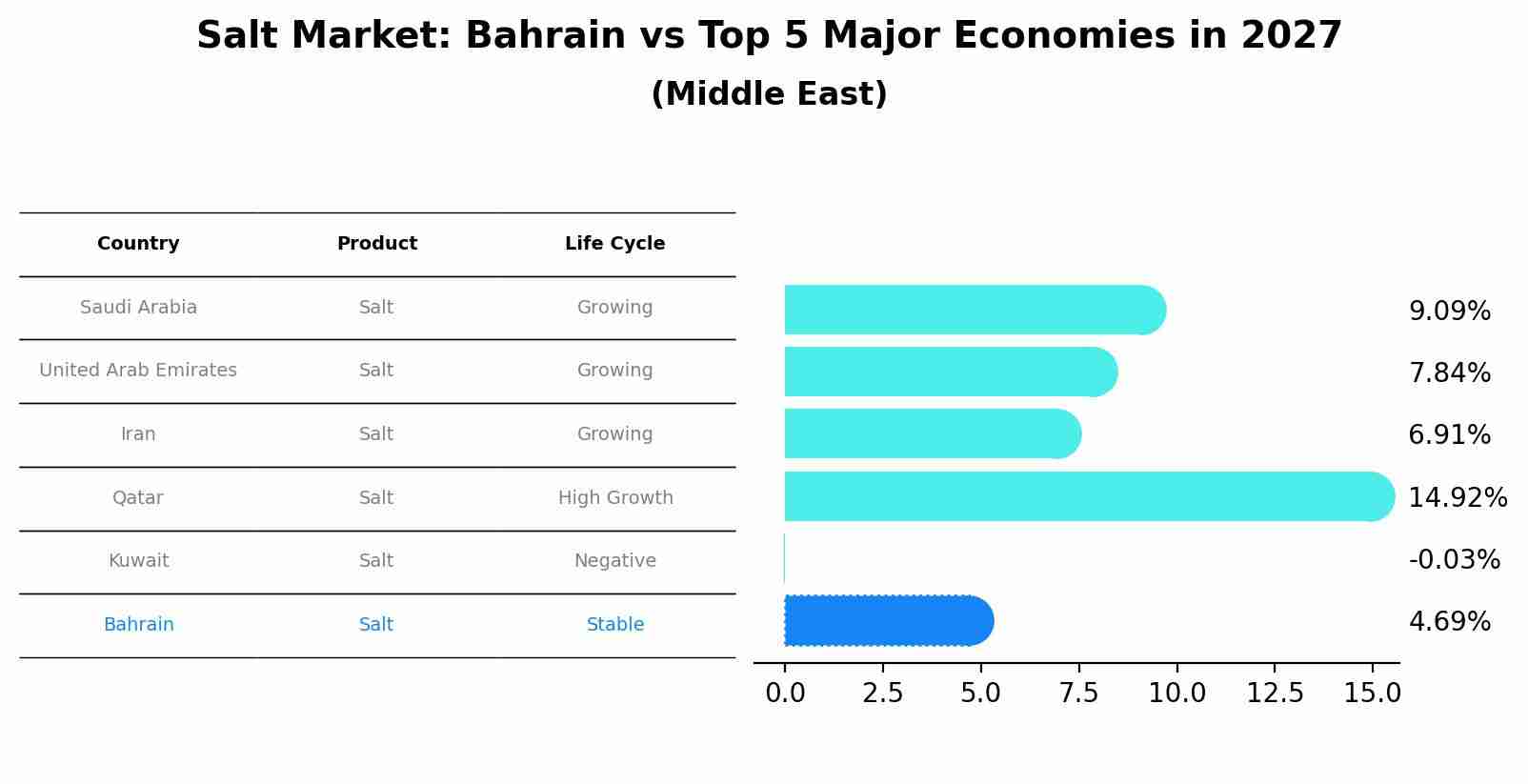Bahrain Salt Market Outlook | Companies, Industry, Analysis, COVID-19 IMPACT, Value, Revenue, Trends, Growth, Size, Share & Forecast
| Product Code: ETC074523 | Publication Date: Jun 2021 | Updated Date: Apr 2025 | Product Type: Report | |
| Publisher: 6Wresearch | Author: Ravi Bhandari | No. of Pages: 70 | No. of Figures: 35 | No. of Tables: 5 |
Bahrain Salt Market Size Growth Rate
The Bahrain Salt Market is poised for steady growth rate improvements from 2025 to 2029. Commencing at 0.08% in 2025, growth builds up to 14.66% by 2029.

Salt Market: Bahrain vs Top 5 Major Economies in 2027 (Middle East)
In the Middle East region, the Salt market in Bahrain is projected to expand at a stable growth rate of 4.69% by 2027. The largest economy is Saudi Arabia, followed by United Arab Emirates, Iran, Qatar and Kuwait.

Bahrain Salt Market Overview
Bahrain`s salt market is characterized by the demand for both edible salt and industrial-grade salt. The food industry in Bahrain relies heavily on salt as a key ingredient in food processing, preservation, and seasoning, while industrial sectors such as chemical manufacturing and water treatment require salt for various applications. The growth of Bahrain`s food processing industry, coupled with the country`s infrastructure development, is driving the demand for high-quality salt. As consumer awareness of health and nutrition rises, the market is also seeing a shift toward specialized salts, such as iodized and low-sodium variants, contributing to the diversification of the salt market.
Drivers of the market
The salt market in Bahrain is driven by its extensive use in the food processing industry, chemical manufacturing, and water treatment. Salt remains a vital ingredient for both household and industrial applications, with demand continuing to rise in line with population growth and urbanization. The expanding food and beverage industry in Bahrain, coupled with increasing demand for processed foods, is a key driver of the salt market. Additionally, salt is used in road de-icing, but to a lesser extent, as well as in cosmetic products, contributing to its diverse application range.
Challenges of the market
The Bahrain salt market faces challenges related to environmental regulations and limited production capacity. The extraction of salt can have significant environmental impacts, including habitat disruption and water pollution. Strict environmental laws in Bahrain may restrict salt production activities or require companies to adopt more sustainable practices, which can increase costs. Additionally, the small geographical size of Bahrain limits the expansion of salt production operations, resulting in the need for imports to meet local demand.
Investment opportunities in the Market
The salt market in Bahrain is a stable sector with steady demand from food, industrial, and water treatment applications. Investors can explore opportunities in processing or distributing various types of salt, including table salt, industrial salt, and specialty salts for gourmet cooking, contributing to both domestic consumption and export potential.
Government Policy of the market
The salt market in Bahrain is growing due to its wide range of applications in food preservation, industrial processes, and water treatment. Government policies supporting the food processing industry and encouraging sustainable salt production practices are driving the market. These policies also focus on ensuring the availability of high-quality salt for domestic consumption and industrial use.
Key Highlights of the Report:
- Bahrain Salt Market Outlook
- Market Size of Bahrain Salt Market, 2021
- Forecast of Bahrain Salt Market, 2027
- Historical Data and Forecast of Bahrain Salt Revenues & Volume for the Period 2018 - 2027
- Bahrain Salt Market Trend Evolution
- Bahrain Salt Market Drivers and Challenges
- Bahrain Salt Price Trends
- Bahrain Salt Porter's Five Forces
- Bahrain Salt Industry Life Cycle
- Historical Data and Forecast of Bahrain Salt Market Revenues & Volume By Type for the Period 2018 - 2027
- Historical Data and Forecast of Bahrain Salt Market Revenues & Volume By Rock Salt for the Period 2018 - 2027
- Historical Data and Forecast of Bahrain Salt Market Revenues & Volume By Brine for the Period 2018 - 2027
- Historical Data and Forecast of Bahrain Salt Market Revenues & Volume By Solar Salt for the Period 2018 - 2027
- Historical Data and Forecast of Bahrain Salt Market Revenues & Volume By Others for the Period 2018 - 2027
- Historical Data and Forecast of Bahrain Salt Market Revenues & Volume By Applications for the Period 2018 - 2027
- Historical Data and Forecast of Bahrain Salt Market Revenues & Volume By Chemical Processing for the Period 2018 - 2027
- Historical Data and Forecast of Bahrain Salt Market Revenues & Volume By Road De-icing for the Period 2018 - 2027
- Historical Data and Forecast of Bahrain Salt Market Revenues & Volume By Food Processing for the Period 2018 - 2027
- Historical Data and Forecast of Bahrain Salt Market Revenues & Volume By Others for the Period 2018 - 2027
- Bahrain Salt Import Export Trade Statistics
- Market Opportunity Assessment By Type
- Market Opportunity Assessment By Applications
- Bahrain Salt Top Companies Market Share
- Bahrain Salt Competitive Benchmarking By Technical and Operational Parameters
- Bahrain Salt Company Profiles
- Bahrain Salt Key Strategic Recommendations
Frequently Asked Questions About the Market Study (FAQs):
1 Executive Summary |
2 Introduction |
2.1 Key Highlights of the Report |
2.2 Report Description |
2.3 Market Scope & Segmentation |
2.4 Research Methodology |
2.5 Assumptions |
3 Bahrain Salt Market Overview |
3.1 Bahrain Country Macro Economic Indicators |
3.2 Bahrain Salt Market Revenues & Volume, 2021 & 2027F |
3.3 Bahrain Salt Market - Industry Life Cycle |
3.4 Bahrain Salt Market - Porter's Five Forces |
3.5 Bahrain Salt Market Revenues & Volume Share, By Type, 2021 & 2027F |
3.6 Bahrain Salt Market Revenues & Volume Share, By Applications, 2021 & 2027F |
4 Bahrain Salt Market Dynamics |
4.1 Impact Analysis |
4.2 Market Drivers |
4.3 Market Restraints |
5 Bahrain Salt Market Trends |
6 Bahrain Salt Market, By Types |
6.1 Bahrain Salt Market, By Type |
6.1.1 Overview and Analysis |
6.1.2 Bahrain Salt Market Revenues & Volume, By Type, 2018 - 2027F |
6.1.3 Bahrain Salt Market Revenues & Volume, By Rock Salt, 2018 - 2027F |
6.1.4 Bahrain Salt Market Revenues & Volume, By Brine , 2018 - 2027F |
6.1.5 Bahrain Salt Market Revenues & Volume, By Solar Salt, 2018 - 2027F |
6.1.6 Bahrain Salt Market Revenues & Volume, By Others, 2018 - 2027F |
6.2 Bahrain Salt Market, By Applications |
6.2.1 Overview and Analysis |
6.2.2 Bahrain Salt Market Revenues & Volume, By Chemical Processing, 2018 - 2027F |
6.2.3 Bahrain Salt Market Revenues & Volume, By Road De-icing, 2018 - 2027F |
6.2.4 Bahrain Salt Market Revenues & Volume, By Food Processing, 2018 - 2027F |
6.2.5 Bahrain Salt Market Revenues & Volume, By Others, 2018 - 2027F |
7 Bahrain Salt Market Import-Export Trade Statistics |
7.1 Bahrain Salt Market Export to Major Countries |
7.2 Bahrain Salt Market Imports from Major Countries |
8 Bahrain Salt Market Key Performance Indicators |
9 Bahrain Salt Market - Opportunity Assessment |
9.1 Bahrain Salt Market Opportunity Assessment, By Type, 2021 & 2027F |
9.2 Bahrain Salt Market Opportunity Assessment, By Applications, 2021 & 2027F |
10 Bahrain Salt Market - Competitive Landscape |
10.1 Bahrain Salt Market Revenue Share, By Companies, 2021 |
10.2 Bahrain Salt Market Competitive Benchmarking, By Operating and Technical Parameters |
11 Company Profiles |
12 Recommendations |
13 Disclaimer |
- Single User License$ 1,995
- Department License$ 2,400
- Site License$ 3,120
- Global License$ 3,795
Search
Related Reports
- Middle East OLED Market (2025-2031) | Outlook, Forecast, Revenue, Growth, Companies, Analysis, Industry, Share, Trends, Value & Size
- Taiwan Electric Truck Market (2025-2031) | Outlook, Industry, Revenue, Size, Forecast, Growth, Analysis, Share, Companies, Value & Trends
- South Korea Electric Bus Market (2025-2031) | Outlook, Industry, Companies, Analysis, Size, Revenue, Value, Forecast, Trends, Growth & Share
- Vietnam Electric Vehicle Charging Infrastructure Market (2025-2031) | Outlook, Analysis, Forecast, Trends, Growth, Share, Industry, Companies, Size, Value & Revenue
- Vietnam Meat Market (2025-2031) | Companies, Industry, Forecast, Value, Trends, Analysis, Share, Growth, Revenue, Size & Outlook
- Vietnam Spices Market (2025-2031) | Companies, Revenue, Share, Value, Growth, Trends, Industry, Forecast, Outlook, Size & Analysis
- Iran Portable Fire Extinguisher Market (2025-2031) | Value, Forecast, Companies, Industry, Analysis, Trends, Growth, Revenue, Size & Share
- Philippines Animal Feed Market (2025-2031) | Companies, industry, Size, Share, Revenue, Analysis, Forecast, Growth, Outlook
- India Lingerie Market (2025-2031) | Companies, Growth, Forecast, Outlook, Size, Value, Revenue, Share, Trends, Analysis & Industry
- India Smoke Detector Market (2025-2031) | Trends, Share, Analysis, Revenue, Companies, Industry, Forecast, Size, Growth & Value
Industry Events and Analyst Meet
Our Clients
Whitepaper
- Middle East & Africa Commercial Security Market Click here to view more.
- Middle East & Africa Fire Safety Systems & Equipment Market Click here to view more.
- GCC Drone Market Click here to view more.
- Middle East Lighting Fixture Market Click here to view more.
- GCC Physical & Perimeter Security Market Click here to view more.
6WResearch In News
- Doha a strategic location for EV manufacturing hub: IPA Qatar
- Demand for luxury TVs surging in the GCC, says Samsung
- Empowering Growth: The Thriving Journey of Bangladesh’s Cable Industry
- Demand for luxury TVs surging in the GCC, says Samsung
- Video call with a traditional healer? Once unthinkable, it’s now common in South Africa
- Intelligent Buildings To Smooth GCC’s Path To Net Zero













